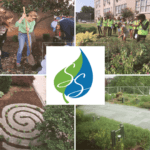Join CCLC in celebrating the life and
achievements of Scotty Guinn Dilworth
with a donation to Scotty Scholars
Chesapeake Bay Landscape Professional (CBLP) Program
Get a CBLP certification and be part of the community of
landscape professionals that design, install, and maintain small-scale
stormwater best practices in the Chesapeake Bay region.

Registration is now open.
Level 1 is our baseline credential that covers design, installation, and management of sustainable landscapes and green infrastructure. Each class, led by regional experts, incorporates classroom work with a field-based practicum and BMP inspection/verification training. CBLP emphasizes critical thinking, interactive learning, and collaborative practice.
Registration is a 2-step process. Before signing up for a class, you must submit an online application. Once the application is approved, you will receive an auto-reply email. Then, you may return to the website to pay and choose your dates. For more info, or to apply visit our training calendar.
 CCLC Establishes the Scotty Scholars Fund
CCLC Establishes the Scotty Scholars Fund
Scotty Guinn Dilworth (1965-2022), was a certified CBLP and small business owner of SG Designs, an award winning and innovative sustainable landscape design firm in the Richmond Area. Through her landscape design business, Scotty employed and mentored young professionals destined for careers in the landscape design industry and taught others to value sustainable landscape and green infrastructure maintenance and the people that do it. Scotty was an incredibly creative and caring person who loved nature, believed we can repair the planet and live sustainably together in the future, and worked to engage and inspire generations of young people to do the same.

For a cleaner Chesapeake Bay, start with the maintenance crew
It all begins with a single, innocuous raindrop.
Instead of splattering onto soil and oozing into the ground, as it would have done a half-millennium ago, the droplet lands on a roof, road or parking lot. From there, it zips along one hard surface to another. Until this tiny traveler finds a larger body of water — a ditch, a creek, the Potomac River — it is fair game for any pollutant that wants to tag along . . . READ MORE
Why Conservation Landscaping?
Our actions are closely linked to the health of the Chesapeake Bay. Stewardship of the land and water by each and every one of us is our most effective tool to improve and protect the Bay. Conservation landscaping is working with nature to reduce pollution. Conservation-focused landscapes incorporate environmentally-sensitive design, minimize polluted runoff, conserve water and are planted with native plants. They protect the soil and are maintained using the minimum amount of chemicals to help protect clean air and water, support wildlife, and provide a more beautiful, healthier human environment.
With so many people living and moving into the Chesapeake region, polluted runoff from streets, farms, construction sites and yards, has become an increasing problem. Contaminants from every home and community—sediments, sewage, manure, fertilizers, pesticides, herbicides and motor oil—can be carried into the Bay from local streams and waterways. How we manage our landscapes is important to all of us! You can embrace the responsibility of caring for the land, and protect the Chesapeake Bay by applying the principles of conservation landscaping. We invite you to explore our web resources, participate in our events, subscribe to our listserve or donate your time or money to support these learning opportunities. Each of us has the opportunity to protect the future health of our communities and Bay by how we envision and care for our landscapes.
